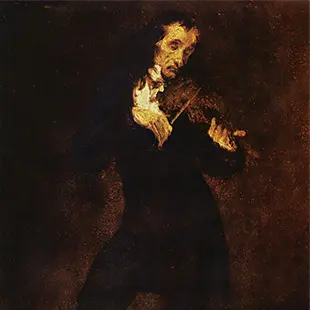Franz Liszt: 8 Bold Piano Pieces for Players of All Levels
Take a spin into the music of the infamous 19th century composer and discover new songs for your repertoire.
Last updated on 25 Sept. 2024
Franz Liszt is often cited as the world's first rock star: During his shows, women reportedly threw clothing at him and fought over anything he touched (cigar butts, handkerchiefs, locks of his hair). He was also one of the most active and prolific piano composers of 19th-century Europe. Born in Hungary, Liszt often incorporated the melodies of his homeland into his formal pieces, a few of which you’ll find below, and was an all around musical innovator. And he used his stardom for good—regularly donating the proceeds of his performances to charity.
Even if you didn't already know these things about him, you've likely heard his work. His dynamic, virtuosic compositions show up regularly in film and television—for example, the classic film Who Framed Roger Rabbit or the perennial Saturday-morning favorite Looney Tunes. His pieces range from perfect-love-story beautiful to downright scary, so there’s something for every player to discover.
We’ve selected eight of our favorite pieces you can learn right now with flowkey. They're available in various levels, from beginner to advanced—including one that's considered among the most difficult piano compositions of all time.
1. Liebestraum No. 3
The classic “love dream”
If there was ever a platonic ideal of a love song for the piano, "Liebestraum No. 3" would be it. Dreamy, beautiful, heartbreaking, it wouldn’t be out of place playing a bride down the aisle or floating softly in the wind on a peaceful summer day. Liszt composed the song around a poem by Ferdinand Freiligrath—with lyrics like "O love as long as you can love," it reminds us to make the most of the short time we have here.
"Liebestraum No. 3" is available to learn with flowkey in levels from beginner to pro. Advanced players will find the composition provides tonal challenge, with its swelling melodies and plenty of room to add interpretation and emotion. Beyond being an excellent piece for building hand coordination, it offers newer learners the chance to explore how rests and pedaling can influence a piece's mood. In short, this is a rippling, rock-hard classic, and no piano player should be without it.
2. Hungarian Rhapsody No. 2
Bugs Bunny, Tom and Jerry, and Franz Liszt
This lively and humorous piece is often used to express virtuosity and comedy in film and television: If you've seen Looney Tunes or Who Framed Roger Rabbit, you’ve definitely heard it. Adorned with folk melodies from Liszt’s childhood, this bouncy piece could easily be at home during a rollicking party or played on a public piano to awe a crowd.
One of the most interesting aspects of this piece are its tempo changes. Ranging from slow and marchlike to impossibly fast, the rapid turns of pace present an exciting challenge to players of every level. This piece contains multitudes—no matter your ability, you can find a passage to practice and play to wow friends, strangers, and especially yourself.
3. Nuages gris
An experimental storm
Showcasing Liszt at his most moody, "Nuages gris," or “Gray clouds,” sounds closer to a coming thunderstorm than just about anything else in the classical canon. Highly experimental for its time, the piece is nearly atonal—seemingly without a "home" note or regular melody. In this way Liszt predicted qualities that came to define 20th century music.
The advanced-level composition is available to learn on flowkey. It offers an opportunity to practice holding spaciousness in both the left and right hands, with a structure that carries little repetition. Beginners may like to give it a try too, if only to spend time with a piece developed around a mood rather than melody.
4. 5 little Piano Pieces S. 192 – Movements I, II, III, IV
Short, sweet moments at the piano
These pieces were composed over 14 years and only truly combined into a set when they were published in the 20th century, long after Liszt's death. All dedicated to a female friend of Liszt’s, they remain some of the most touching and thoughtful short pieces in classical piano composition. These are often played around the world at piano “recitals” (a term which Liszt coined) and belong in any piano player’s repertoire.
Any one of these pieces is perfect for a little detour that can be played in its entirety in a short period of time. The titles are actually playing directions: Adagio, meaning slowly; Moderato, meaning played at a moderate tempo; and Andantino, meaning slightly faster. If you’d like a small taste of what Liszt is all about, these are a great place to start.
5. Lento placido – Consolation No. 3 in D♭ Major
A dreamy arrangement likely inspired by Chopin
A fan of Chopin, Liszt likely drew inspiration from the composer's works. This is particularly apparent in "Consolation No. 3," which was composed around the time of Chopin's death and starts in a similar way to "Nocturne No. 2 in D♭, Op. 27." Like the works that inspired it, this piece, meant to be played "slowly and placidly" (lento placido), is evocative of the night.
This is a beautiful piece for building hand coordination and practicing rhythm—that is, if you can resist its dreamy pull and stay focused as you play it. It's also a great piece for practicing your pedaling, and if your piano happens to have a sostenuto pedal, you'll discover some opportunities to give it a try, too.
6. La campanella
One of the most difficult (and rewarding) piano pieces ever composed
If you’re looking to show off—or challenge yourself to the max—look no further. Widely considered to be one of the most difficult pieces ever composed for the piano, "La campanella" is a marvel of finger dexterity and hand independence. Its melody comes from a movement in Niccolò Paganini's Violin Concerto No. 2 in B Minor, Op. 7, which so inspired Liszt that he adapted it for piano. The name translates to “Little Bell” in English and refers to the Italian folk song at the piece's roots.
flowkey offers a shortened and slightly simplified version of this piece, but players will still find their fingers leaping great distances, their arms crossing over one another, and their hands virtually on top of each other while practicing. The rewards are magnificent, even in this simpler form. If you're just starting out, you can start even simpler, with the intermediate-level arrangement, and work your way up.
7. Funérailles
Requiem for a revolution
Liszt wrote this dark, dissonant, and undeniably passionate piece in response to the failure of the Hungarian Revolution of 1848. After enacting democratic reforms, the Hungarians’ dreams of independence were ultimately crushed by the Austrian empire, and a number of Liszt’s friends and acquaintances were killed or exiled. The Hungarians would not see independence until the end of the First World War, and sadly, Liszt would not live to see his birth country free.
In keeping with the somber, regretful, and sometimes angry tone of its composition, this piece should be played both with great bravery and deep emotion. It’s perfect for times of sadness or regret, and an important reminder of music’s transformational power. "Funérailles" is one of those works of art that helps us express and process all of our emotions—not just the positive ones.
Read: The 14 Classical Piano Pieces Every Musician Should Know
8. Dance of the Dead
Music as memento mori
This powerful, almost scary piece, serves as something of a memento mori—a reminder that death will someday come for us all. Rather than being something terrifying and awful, though, artworks of this style are a reminder to live your truth and live life well. We only get one. In this case, a life well lived invariably includes the power of music.
Perhaps not so ironically, pianists can have a good bit of fun with this piece, which contains a number of slides that are nearly the entire length of the keyboard and often played with the back or side of the fingers. Players can also have fun with the ticking clocklike melody of the left hand and the alarm-clock right, reminding us of time’s endless march. A great song for Halloween, and all occasions where players might want a dose of old-fashioned life-or-death reality in their playing.
Play the music you love and discover new favorites with flowkey
With flowkey, you never have to wonder what to play next. Our library is full of music in various genres and levels, so players of all abilities can learn the songs they love and find their next favorite.
We hope one of the Liszt songs above has captured your imagination, but if you're craving something else, we have loads of other easy-to-learn classics from the world's most famous composers—and some lesser-known but equally brilliant greats, for that matter. Try out flowkey today and discover your passion.
Read next
5 Beethoven Piano Pieces to Learn for Players of All Levels
Playing Beethoven on piano can be a full-body experience. We've gathered the five pieces we believe best showcase his brilliance—for pianists of all levels.
Claude Debussy: 10 Essential Piano Pieces
Debussy's dreamy compositions remind us of the moving power of music. Discover a new song to learn with our list of 10 of his best pieces.
Learning Piano When You Already Play Another Instrument
You don't have to start from scratch if you want to learn a new instrument. Here we offer suggestions to craft a fun and motivating piano-learning journey for yourself.
Baroque, Romantic, Contemporary: Famous Piano Composers Across the Eras
Take a trip through piano history, from the Baroque right up to the Contemporary period, and learn more about the composers that defined each era.









